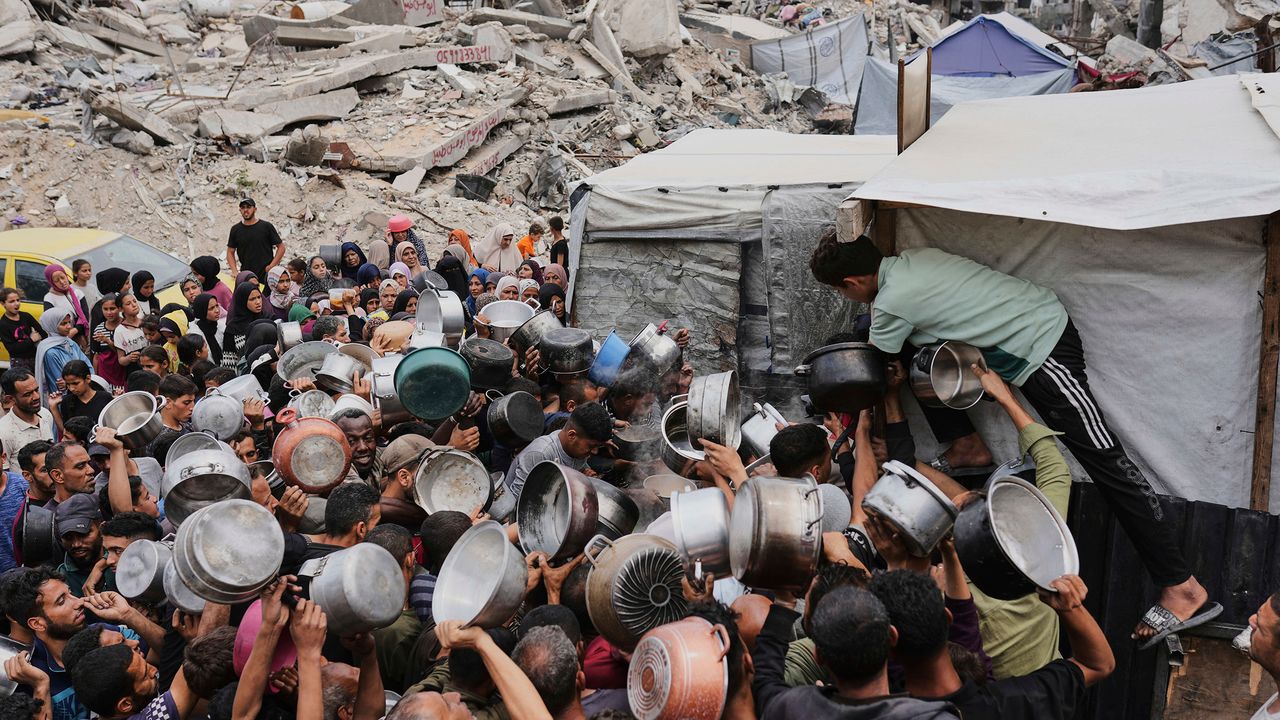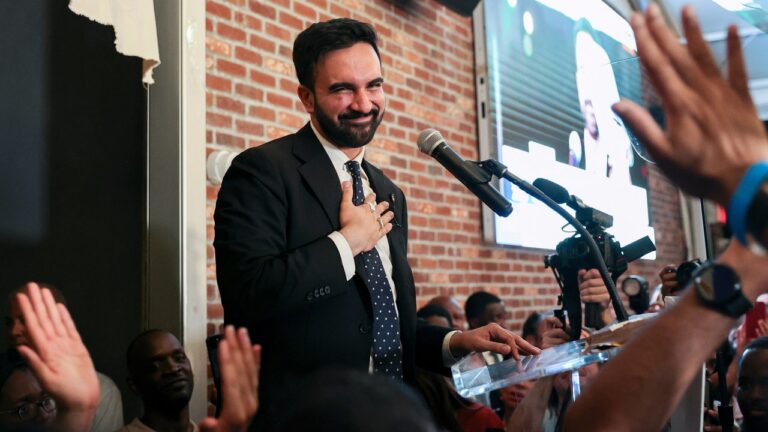For more than two months, the Israeli government blocked humanitarian aid from entering Gaza. On Monday, it allowed in several trucks carrying baby food and other necessities, and on Tuesday it claimed that it had let in ninety-three additional trucks. (The United Nations said that none of Tuesday’s trucks reached their destination, however. Humanitarian organizations, which have been warning of a widespread hunger crisis, estimate that at least five hundred trucks per day are needed.) The announcement of this trickle of aid was made by the Israeli Prime Minister, Benjamin Netanyahu, who called it “minimal” and attributed its delivery to the pressure of “friends” abroad, who told him, “ ‘We cannot accept images of hunger, mass hunger. We cannot stand that. We will not be able to support you.’ ” Netanyahu added, “We must not reach a point of starvation—both as a matter of fact but also as a diplomatic issue.” He simultaneously has declared that Israel is embarking on a dramatic escalation of the war.
Shira Efron is a research director and a senior fellow at the Israel Policy Forum, an American think tank which advocates for a two-state solution to the Israeli-Palestinian conflict. Efron, who lives in Israel, used to be a researcher at the RAND Corporation, and has advised the United Nations, where she worked on issues relating to the humanitarian situation in the Gaza Strip. She was also formerly a reservist for the Coordination of Government Activities in the Territories, or COGAT, which supervises civilian policy in Gaza and the West Bank, and which has been accused by humanitarian organizations of preventing adequate food supplies from reaching Gazans. (COGAT is overseen by the Ministry of Defense.)
I wanted to speak to Efron because of her knowledge of Israeli government policy, and to discuss why her concern about the lack of access to food and supplies in Gaza had reached such a high level. We talked on Sunday, as the next phase of the war was getting under way, and did a brief follow-up on Tuesday. We ended up touching on a number of topics, including her evaluation of the dire health of Gaza’s population, disagreements between parts of the Israeli bureaucracy and Israeli politicians, and Netanyahu’s ultimate aims.
How bad do you think the food and aid situation is in Gaza currently? And how would you compare it with different times earlier in the war?
I think the situation is horrendous. It’s awful. It was close to eighty days without any aid entering. During the forty-two-day ceasefire, relatively large quantities of aid went into Gaza, but even that was insufficient to meet the demands of the people. We’re talking about dry foods, perishables, and fuel for all systems. So much in Gaza relies on a generator, so fuel is needed for water-purification systems, hospitals, sewage-treatment facilities, any sanitation facilities, pretty much for everything.
We’re also talking about medicines and hygiene kits. We tend to focus on the food, but it’s not just food. In the first few weeks of the war, no aid went into Gaza. The situation started getting pretty bad then. But that was after years of some access. There were always restrictions on access and movement of things going into Gaza, but for the most part there was food production there, food manufacturing, you had agriculture. It wasn’t like today where you have nearly all of Gaza’s population dependent on humanitarian aid. There is virtually zero self-production of food.
After the ceasefire, people in Gaza felt a little bit of respite. Nothing pretty—a lot of them had to recover and try to move from their displaced locations, find deceased family members. But there was a little bit of respite. And the last eighty days have been hell again. I’m hearing from people in international organizations that they ration the food of their own staff to one meal a day.
If we look at food prices in Gaza, we can see the increases. We know perishables are being sold at inflated prices. We know there is a shortage of spare parts for water-purification systems because they’re defined as “dual use.” [Dual-use items are items which could potentially be used for military purposes, as well as or instead of their intended purposes.] We know they’re not getting the right medicines. It’s really bad.
The Times reported last week that a number of people within Israel’s military and security establishment had actually privately come to the same conclusions about the horrific state of aid in Gaza that N.G.O.s and humanitarian workers have warned about for weeks. I know you’re someone who has contacts within the Israeli government. There have been debates previously about how much aid was actually being let in, and questions about whether the number of starving people were being inflated. Is your sense now that everyone, at least privately, is working from the same set of assumptions?
I think that there’s always a difference in assessments between the humanitarian community and the I.D.F. It’s unfortunate. The Israeli mind-set is that the humanitarian community has cried wolf for a long time and things have not materialized. So, when the ceasefire collapsed and the I.D.F. announced that there would not be any aid, the humanitarian community said, “In two to three weeks, the resumption of aid will be needed.” The politicians took the maximalist position of, like, “Oh, no, there’s more time than that.” Privately, people in COGAT and other places were more professional and gave an assessment that food would be needed in sixty to ninety days, which is where we are now.
There were a lot of people in the Israeli establishment who did professional assessments based on how many trucks went in and how much food each person needs based on calories and reached something that was not the official position. Where we are now is a red line that the professionals were driving in private. No one is arguing that we are not there anymore. People in the I.D.F. have said to the politicians that these numbers mean we need to bring in aid. It’s not coincidental that we are now hearing that aid is going to go in. It’s also partially a result of Marco Rubio, Trump, and Steve Witkoff making clear that they’re not going to see a humanitarian catastrophe on their watch. It is a big thing in Israel for all the Americans to say this, and especially Trump himself, which has now paved the way for the Europeans to escalate and put more pressure on. It’s not just the U.N. and the N.G.O.s this time. Although this is pretty much a catastrophe.
When the humanitarian community started freaking out soon after the ceasefire ended, some Israeli officials were saying that there were enough supplies to last for longer, something like four to six months. But you’re saying that privately people acknowledged actually there was much less time, and we’ve reached that deadline? And essentially everyone is on the same page now in their belief that if the aid doesn’t start flowing very quickly, we’re going to have a really large-scale disaster?
I think some people understand it. In the I.D.F., there were different assessments. Malnutrition is not necessarily just the image of thin babies. It’s not just that. You may not see it with the naked eye. The humanitarians are saying that people are malnourished and that it is going to affect their recoveries for life.
There has been enormous pushback from Israeli politicians and media outlets, who argue that the situation is not so bad. What I was trying to establish from you, and I think the Times story went some way to helping understand this, is that there’s widespread agreement among a number of Israeli military officials and people who work on Gaza aid issues that this is a truly terrible situation.
I don’t know if it’s widespread agreement. Because for the Israeli public the way it’s portrayed is that we’re giving humanitarian aid to Gaza while they still have our hostages. It’s a politically charged issue. You have politicians who are catering to their constituencies who don’t want to see aid going into Gaza. And this stands in full contradiction to what Israel needs to do diplomatically. Professionals in the I.D.F. are very aware of where the politicians are. The challenge, I think, for some of these professionals, is how you explain it in terms that are clear and convincing to the politicians. Because, at the end of the day, COGAT cannot decide to open a crossing. Only the politicians can.
This gets to the question of whether the politicians can or even want to be convinced by the facts on the ground, though, right?
Like politicians everywhere, there are different things that could convince them. It’s pretty effective that we heard Rubio talk about it. Witkoff said something. Trump made a statement last week in the Gulf that there are people starving in Gaza. This is an effective way to get Israeli politicians on board with the plan. And you have the assessments from the professionals that it’s needed.
What have you made of the new aid plan that the Israelis and Americans have talked about? Can you explain what it is and why the aid community does not like it?
When the plan was announced initially, it was for a handful of distribution centers in Gaza, but not all over. Each one of them would serve three hundred thousand people. And a representative from each family in Gaza would come at a specific time and day and would collect supplies for their family for the week or whatever period, and come back. There’s an entity called the Gaza Humanitarian Foundation, which would bring the aid kits and all that. When the plan was announced two weeks ago, the criticism it received—and there was really a uniform U.N. opposition to it, and opposition from the N.G.O.s—was first of all that humanitarian principles call for the aid to go to the beneficiaries, not beneficiaries having to come to aid. Weak people, disabled people, pregnant women, old women, children, they can’t walk far. These are heavy packages to carry with no transportation means.
Also, the first brochure of the G.H.F. said that it’s going to supply 1.2 million people at the start. What about the other eight-hundred-thousand-plus people? There is no equal distribution across Gaza, and especially in the north. Gaza is almost entirely dependent on aid—you need support for hospitals, you need community kitchens. When you get your dry pasta in the box, where are you going to cook it? There are barely any homes in Gaza, right? So you need to go to a community kitchen.
The original design of the plan did not have these systemic features. Also, the rationale was that we need to prevent Hamas from exploiting the aid. People will come to secure facilities so that we will know that it’s not going to Hamas. But why wouldn’t Hamas steal the aid or tax it after distribution? We’ve seen it in Iraq, in Yemen—other places where terrorist organizations do it. It’s not just about taking a whole truck. Hamas is a learning organization. It’s very adaptable. It can siphon off aid or do something with the aid after it is received by people. This plan to get people aid assumes lab-like conditions. What if we say, “Seven thousand will come today,” and seventy thousand come? It’s not like they’re busy at work. What are you going to do? I fear a lot of scenarios of stampedes.
The U.N., which was most vocal, said, “We’re not playing ball.” A week ago, the G.H.F. issued a two-page document where it demanded that Israel address some of these vulnerabilities and open distribution centers in the north. We’re talking in a moment when the mechanism is still being shaped. There could be an opportunity for Israel to back away from its maximalist approach, and for the humanitarian community to compromise.
Is there a reason that Israel can’t go back to the old way of doing things—bringing trucks in and having aid dispersed to the population, in the way that we saw during the ceasefire? Is it that they don’t want to work with humanitarian groups?
No. This is a possibility. But in the Israeli mind-set their responsibility is only to enable humanitarian access. Earlier in the war, the attitude was, “We let trucks go in. The U.N. is incompetent. Don’t blame us.” And this was always a wrong approach, in my view, both from a humanitarian perspective and also from a security perspective. For Israel, this model also enabled Hamas to exploit aid. Israel legitimately is looking for ways to choke Hamas off financially. The old model, in its view, does not adequately address that concern.
But you were saying earlier that if Hamas wanted to exploit aid deliveries, it could do it in this new system, too, right?
Yeah, that is my assessment based on lessons learned from other places. But it might be harder. Maybe they can do it less at scale. I think we need to focus on minimizing the Hamas benefits and also insuring a maximalist response for the people. I don’t necessarily agree that the new method is going to make it harder for Hamas to take the aid, but it’s going to be different.
Earlier in the war, Netanyahu said that making sure Gazans had aid was actually important to the task of carrying out the war. What do you think changed when no aid was being let in?
What changed? Shit. One important change was the election in the United States. I think Netanyahu and Israel agreed that providing aid granted Israel legitimacy to continue its fighting effort. I think the change in Washington made some Israelis assume that Israel will get carte blanche to continue the fighting without needing to account for aid. The assumption was that the Trump Administration will not care. The latest statements of Trump officials show that this is not the case; they actually do care. I don’t know what their motive is.
I asked why the aid plan had changed, and you said that the Israeli government wants to pursue a route that prevents Hamas from stealing aid as easily. And then I asked why Netanyahu seemed to drift from his contention, early in the war, that aid was important to Israel successfully prosecuting it. And you said, basically, “Well, they can get away with what they want now because Trump’s in office.”
I think it’s what they thought—that they could get away with it.
There seems to be a little bit of tension between the two answers, no?
No, no, no. Listen, humanitarian assistance to Gaza is not a popular thing. O.K.? It’s not a popular thing. But for the most part Netanyahu and others in the system have understood that the international community . . . Well, if it was up to the Israelis, maybe there won’t be any aid going to Gaza. I don’t know. I don’t know. It wasn’t a priority. In the Israeli mind-set, the population has been complicit with Hamas. But to continue receiving support from the international community—it was in Israel’s interest. For Netanyahu, permitting some aid in now allows for more legitimacy for the war and the continued fighting. And the message to his right-wing Cabinet members and political base is that he was forced to do this if they want to continue the war, and we can’t say no to Trump.
Near the beginning of the war, everything only opened, in terms of aid, because of American pressure. There was an assumption that the Trump people were not going to care like the Biden Administration did. I don’t think Israel said, “Oh, we’re going to starve those guys to death. We’re just going to never provide aid.” It was more like, “We have a window to come up with something different.” And this window was enabled by the fact that Trump is in the White House and not Biden. If it was Biden, I don’t think that Israel would have been allowed to go for almost eighty days without providing any assistance. But Trump’s position now seems to have changed.
How have your opinions of the Netanyahu government’s intentions changed in the past year and a half?
There are people in the government who have made their intentions very clear at the onset, and those intentions were emptying Gaza of its inhabitants, expelling them, and returning the Jewish settlements there. I never thought this was the intent of Netanyahu himself, and I don’t think it is the intent now, but it seems that . . . How should I say this in a way that’s not terrible?
Well, just say it how you think it.
No, I can’t. I can’t. [Trails off.] It seems that Netanyahu himself has treated Hamas as an asset and the Palestinian Authority as a liability and tried to make sure that there’s a divide between them, because Hamas enabled an Israeli policy that would not advance diplomatic solutions to the Palestinian issue. I think when October 7th happened, it was very clear that this can no longer continue. The idea of defeating Hamas, whatever it means, or getting rid of the Hamas role, is something that Israel is serious about.
But as the war is prolonged, it seems more and more that Hamas remaining in power could serve the interest of the Netanyahu government because it allows them to not launch a commission of inquiry, which is one thing that the Israeli public wants, and it’s the excuse of not going to elections in which they’re probably going to lose. And so I think it’s hard for me to disconnect the goals of the war from the strategy of Netanyahu to achieve his political survival and personal survival.
So you don’t think that Netanyahu himself is trying to put into a place a plan to starve Gazans, but that may be the upshot of the scenario? And he is pushing to see what he can get away with for other reasons? And moreover that there are people in his government who may want ethnic cleansing or whatever else? And he wants a forever war?
I think you are confusing two things. The war aims were defined as bringing back the hostages and dismantling Hamas. Those were the war aims. I’m separating the whole discussion about food aid. They are not connected. They’re not connected.
I was trying to make a separate point, which you may disagree with, which was simply that if you’re in a place where you’re directing a forever war, then some really bad things are going to happen. And you’ve got a bunch of crazy people in your coalition. I hear you saying that Netanyahu is not trying to intentionally starve people, and you don’t think that’s his plan, per se, but if he does want a forever war, and we know the conditions in Gaza—when you will the ends, you sometimes will the means, too.
I don’t know. I think that maybe we’re coming to a point when the clock has run out. But I do think we need to distinguish between the war aims and the tactics that have to do with the civilians. Netanyahu himself said something like, “If the Gazans are in a place without Hamas, as far as I’m concerned, they can have Ben & Jerry’s ice cream there.”
Oh, that’s terrific.
I don’t know if he cares what they eat or not.
You laid out these concerns about the new aid plan. Are you concerned that even if aid is flooded into Gaza pretty soon, we’re still looking at a crisis for a good amount of time just because of distribution issues, and how behind we are? You wrote a version of this point during the ceasefire, when aid was coming in.
Listen, the situation in Gaza is so bad. There are barely any homes standing. People have not eaten well, or worked, and there is trauma, and death, and a huge number of disabled people. For aid to start coming in, it’s necessary but hardly sufficient. We’re going to be in this humanitarian stage, and then emergency recovery and all these things. I mean it needs far more than just counting some trucks. You need that, don’t get me wrong, but for a meaningful improvement, you need far more than that. I am also worried about what too little aid means. It could lead to stampedes and looting and other problems. We have seen a mother and two daughters getting crushed to death while standing in line at a bakery. Everyone we talked to from Gaza, everyone, is just in survival mode. I’m encouraged to see that some aid is going in, but it’s a drop in the ocean. This is a humanitarian catastrophe that will take years to overcome. ♦









